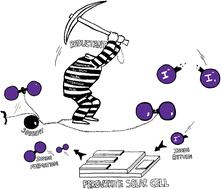当前位置:
X-MOL 学术
›
Energy Environ. Sci.
›
论文详情
Our official English website, www.x-mol.net, welcomes your feedback! (Note: you will need to create a separate account there.)
A comparison of molecular iodine evolution on the chemistry of lead and tin perovskites
Energy & Environmental Science ( IF 32.5 ) Pub Date : 2024-04-24 , DOI: 10.1039/d3ee03004k Thomas Webb 1 , Saif A. Haque 1
Energy & Environmental Science ( IF 32.5 ) Pub Date : 2024-04-24 , DOI: 10.1039/d3ee03004k Thomas Webb 1 , Saif A. Haque 1
Affiliation

|
The development of perovskite solar cells (PSCs) has gone from strength to strength over the last decade, enabling low-cost, flexible and high-efficiency photovoltaic devices. However, the significance of molecular iodine (I2) evolution within the perovskite layer on device longevity is only recently becoming realised. In lead-based perovskites, the formation of I2 is determinantal to both the photovoltaic performance of PSCs and the long-term stability. Likewise, I2 formation within tin perovskite is highly destructive; rapidly breaking down the composition of the perovskite layer, and severely limiting the shelf-life of photovoltaic devices. In both cases, the formation of I2 has a significant additional impact on the stability and function of all other elements of the PSC structure including the conductive metal oxide, metal electrode and charge transport layers (CTLs). In this perspective, we highlight the key role of iodine in dictating the performance and stability of lead and tin perovskite materials. In doing so we compare the similarities and differences between the formation mechanisms of molecular I2 in the lead and tin analogues while also considering its effect on the performance of PSCs through consideration of the various elements of the PSC structure. In discussing this challenge, we look to identify new emerging ways in which volatile iodine has been captured within other scientific fields and discuss the applicability, modification and utilisation of these strategies within PSCs. Finally, through consideration of the fundamental chemistry in these systems, we summarise the all-important role of iodine in PSCs, discuss efforts being made to mitigate the damage of I2 evolution, manage the redox chemistry, and provide design criteria for developing iodine-resilient PSCs.
中文翻译:

铅和锡钙钛矿化学中分子碘演化的比较
过去十年来,钙钛矿太阳能电池(PSC)的发展不断壮大,实现了低成本、灵活和高效的光伏设备。然而,钙钛矿层内分子碘 (I 2 ) 的演化对器件寿命的重要性直到最近才被认识到。在铅基钙钛矿中,I 2的形成对于PSC的光伏性能和长期稳定性至关重要。同样,锡钙钛矿内的 I 2形成具有高度破坏性;迅速分解钙钛矿层的成分,并严重限制光伏器件的保质期。在这两种情况下,I 2的形成对PSC结构的所有其他元件(包括导电金属氧化物、金属电极和电荷传输层(CTL))的稳定性和功能具有显着的额外影响。从这个角度来看,我们强调碘在决定铅和锡钙钛矿材料的性能和稳定性方面的关键作用。在此过程中,我们比较了铅和锡类似物中分子 I 2形成机制的异同,同时通过考虑 PSC 结构的各个元素来考虑其对 PSC 性能的影响。在讨论这一挑战时,我们希望找出其他科学领域中捕获挥发性碘的新方法,并讨论这些策略在 PSC 中的适用性、修改和利用。最后,通过考虑这些系统中的基本化学,我们总结了碘在 PSC 中的重要作用,讨论了为减轻 I 2演化的损害、管理氧化还原化学所做的努力,并为开发碘提供了设计标准。有弹性的 PSC。
更新日期:2024-04-29
中文翻译:

铅和锡钙钛矿化学中分子碘演化的比较
过去十年来,钙钛矿太阳能电池(PSC)的发展不断壮大,实现了低成本、灵活和高效的光伏设备。然而,钙钛矿层内分子碘 (I 2 ) 的演化对器件寿命的重要性直到最近才被认识到。在铅基钙钛矿中,I 2的形成对于PSC的光伏性能和长期稳定性至关重要。同样,锡钙钛矿内的 I 2形成具有高度破坏性;迅速分解钙钛矿层的成分,并严重限制光伏器件的保质期。在这两种情况下,I 2的形成对PSC结构的所有其他元件(包括导电金属氧化物、金属电极和电荷传输层(CTL))的稳定性和功能具有显着的额外影响。从这个角度来看,我们强调碘在决定铅和锡钙钛矿材料的性能和稳定性方面的关键作用。在此过程中,我们比较了铅和锡类似物中分子 I 2形成机制的异同,同时通过考虑 PSC 结构的各个元素来考虑其对 PSC 性能的影响。在讨论这一挑战时,我们希望找出其他科学领域中捕获挥发性碘的新方法,并讨论这些策略在 PSC 中的适用性、修改和利用。最后,通过考虑这些系统中的基本化学,我们总结了碘在 PSC 中的重要作用,讨论了为减轻 I 2演化的损害、管理氧化还原化学所做的努力,并为开发碘提供了设计标准。有弹性的 PSC。



























 京公网安备 11010802027423号
京公网安备 11010802027423号